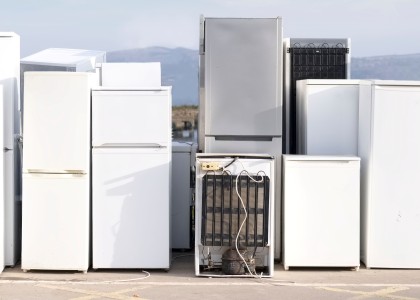Executive Summary
Key Findings:
|
A previous ACEEE study examined all the individual homes in the 2015 Residential Energy Consumption Survey (RECS) and found that on average for 1–4 family buildings, the lowest-cost decarbonization option was an air-source heat pump powered by a clean electric grid for locations below 6,000 heating degree days (HDD). Above 6,000 HDD, the low-cost option was a hybrid system that combines a cold climate heat pump with a fuel-fired backup system.
Our new study expands this analysis by looking individually at homes in the 2020 RECS data set and adding scenarios that examine the impact of electrification and gas pipe replacement on gas distribution costs, adding ground-source heat pumps, and delving into multiple hybrid heating options for cold climates. We focus on existing homes and assume that they need to install a new heating system in 2030 when their existing heating system reaches end-of-life.
Alternative hybrid-fuel options to backup heat pumps in cold climates include biogas, propane derived from biofuels, and biodiesel;[1] use of these fuels can reduce but not eliminate greenhouse gas emissions. The 2020 RECS contains more than 2,000 gas-heated homes in climates above 6,000 HDD. We analyze each of these homes and summarize how each of the options affects consumer life-cycle energy costs. Our analysis includes the impact of increased electrification on peak winter power demand and hence on electricity prices.
However, we caution that future biofuel prices are subject to substantial uncertainty; we examine alternative prices in the body of the report and an appendix. We also note that these fuels can vary greatly in their greenhouse gas emissions, as well as in local air quality and other impacts. The use of biofuels offers carbon reduction but not true decarbonization as biofuels still emit greenhouse gas emissions when burned, with only some of those emissions offset by accounting for the carbon captured during growth of its feedstock. The reader should not ascribe equivalent greenhouse emissions reductions to these alternative fuel pathways.
Lower-carbon alternatives to natural gas warm-air furnaces
We examine the life-cycle costs for space heating, comparing several heat pump systems to furnaces that burn lower-carbon alternative fuels such as biogas. We individually examine each cold climate home in the 2020 RECS; for each system type, we then construct best-fit lines. We consider scenarios with no change to gas distribution systems, with fewer gas customers due to electrification, and with higher costs for cold-climate heat pumps. Figure ES-1 shows this approach for a subset of system types and scenarios.
Figure ES-1. Comparison of life-cycle costs for space heating with warm-air distribution for three heating system types and three scenarios. Costs are in 2023 dollars.
As the figure shows, for climates similar to the current climate in Concord, New Hampshire or Madison, Wisconsin (i.e., above approximately 7,000 HDD), under our assumptions, a hybrid cold climate heat pump system with a biogas backup will minimize life-cycle space heating costs. Relative to our prior 2022 study, the dividing line between using only heat pumps and using a hybrid system increases from 6,000 to 7,000 HDD due to use of newer RECS data and to revisions to heating system and biogas costs.
As a reduced carbon backup fuel for hybrid systems, we find that biogas supplied via existing gas distribution systems has the lowest life-cycle costs—assuming pipes do not need to be replaced and most customers stay on the gas system. If these conditions do not apply then propane made from biogas, followed closely by propane made from ethanol, generally has the lowest life-cycle costs, and B100 and renewable diesel are only a little more expensive. For a substantial majority of homes, a 100-gallon tank filled annually by truck would meet backup needs for an entire winter.
Our results indicate that there may be viable routes to decommission gas distribution systems in cold climates and provide backup heat via delivered fuels.
Lower-carbon alternatives to natural gas hot-water boilers
For boilers, we find that an air-to-water heat pump combined with a moderate weatherization package (along the lines of Home Performance with ENERGY STAR) will typically minimize life-cycle energy costs. The weatherization both reduces life-cycle costs and helps each room to have adequate heat with lower hot-water temperatures provided by the heat pump. Without weatherization, a backup boiler will often be needed in cold climates to provide adequate heat in each room, raising the hot-water temperature to the 160–180°F for which most hot-water distribution systems are designed. However, for unweatherized homes in climates below 9000 HDD (approx. Duluth), adding a backup boiler will increase life cycle costs compared to installing an air to water heat pump.
Energy efficiency remains critical
In all of these scenarios, either a moderate energy efficiency package (e.g., a typical Home Performance with ENERGY STAR package) or a deep retrofit at the time of a major remodel will reduce life-cycle space heating costs. These packages also improve resident comfort.
Conclusion
Overall, we find that electrification of most space heating is possible and can be cost effective in even cold climates. However, some use of biofuels can be useful as a backup to reduce consumer life-cycle space heating costs and to keep winter peak electric demand from rising too fast. It is essential to note that while useful, biofuels do not reduce greenhouse gas emissions as much as electric heat pumps with a low-carbon electricity supply.
[1] Wood and hydrogen are other potential options, but we did not examine these for reasons that we explain later in the report.
| Suggested Citation |
Nadel, Steve, and Lyla Fadali. 2024. Options for Decarbonizing Residential Space Heating in Cold Climates. Washington, DC: ACEEE. www.aceee.org/research-report/b2404. |





